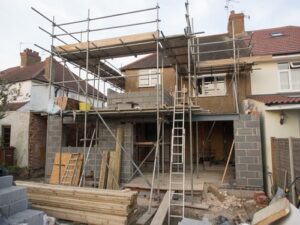13 May 2021
Planning
Nothing New
by Lynda Goetz
 My son’s hopes of exchanging on his first property this week were dashed on Monday when his solicitor reported that the vendors have a problem with their purchase – it appears that the garage of the house they are attempting to buy had been built without planning permission. Bad news.
My son’s hopes of exchanging on his first property this week were dashed on Monday when his solicitor reported that the vendors have a problem with their purchase – it appears that the garage of the house they are attempting to buy had been built without planning permission. Bad news.
‘Planning permission’ is a concept which dates back to the Town and Country Planning Act 1932. This Act extended quite considerably the powers of local authorities in relation to planning schemes set up earlier in the century by the Housing and Town Planning Act 1909 and the 1919 Town Planning Act ten years later. However by the end of World War II it seemed that more legislation was required. There was a conflict between those who wanted to protect the countryside and those who wanted adequate space for homes. (Sound familiar?) Central Government stepped in and with the 1947 Town and Country Planning Act established a system with three key components: firstly nationalising development rights; secondly creating Local Development Plans and thirdly ensuring the submission of all proposed development to a discretionary planning consent process guided by these development plans as well as specific building standards. Although financial considerations, criticism of the post-war estates, arguments about the role of the Local Plan and concerns about the supply of new housing have all caused fluctuations in the way planning consent has been dealt with over the last 70 years, there has been no fundamental review of the 1947 act.

In the Queen’s speech this week, a new Planning Bill was one of 25 ‘Her Majesty’s Government’ was intending to introduce. ‘’Biggest shake-up for 70 years”, trumpeted The Sun; “Johnson’s Planning Laws an ‘utter disaster’ say countryside campaigners”, wailed The Guardian. The aim of the bill is to ease the way for the Government to reach its target of building 300,000[i] houses a year by clearing obstacles currently seen as delaying the planning process. Robert Jenrick, the Housing Secretary has already said that the previously announced ‘right to regenerate’ will make it easier for companies, community groups and individuals to challenge councils and public sector bodies to release land for development. Current laws favour large developers (currently smaller firms build just 12% of new homes) but new developments can take a long time to move from drawing board to implementation. The building industry appears to have given the new plans as outlined a cautious welcome, but in view of the non-attainment of government targets for building over the last 20 years, remains sceptical about delivery.
It is clear that more houses need to be built to meet growing population and demand. The main questions seem to be ‘Where?’ and ‘How Quickly? The new bill is expected to include ‘zoning’, whereby the country is divided into areas which are either marked for growth, protection or renewal. In areas marked for growth, developers will be allowed to build homes and also related infrastructure such as schools, without individual planning consent. One of the aims will be to simplify environmental assessments now that we are no longer subject to EU regulations. The Council for the Protection of Rural England (CPRE)[ii] warned that the bill, which will largely apply only in England, ran counter to the proposed Environmental Bill and would “take us back to a deregulated dark age of development”. It fears most of the new homes are unlikely to be low-cost or affordable.
Even within the Conservative party itself, welcome for the bill is not unalloyed. The former Prime Minister, Theresa May, as well as others, has apparently expressed some concerns, in particular over the possibility that ‘local involvement’ in the planning process will be limited. Once an area has been designated as a growth area, the possibility for local councils and residents to object to developments will be severely limited. Whilst this will clearly speed things up, it does reduce local democracy. Other changes will relate to funding infrastructure and incorporating a National Model Design code, which will include a 10-point checklist of design principles.

The Town & Country Planning Act 1947 was by no means the beginning of government interference in the way land was used, towns and cities laid out or buildings erected and used. Createstreets.com, a foundation set up in 2013 to help ‘co-create beautiful, sustainable, prosperous, economically and socially successful places with strong local support and which residents will love for generations,’ has a fascinating and pertinent article on its website, posted two years ago by its founder, Nicholas Boys Smith. In ‘The Long History of British Land Use Regulation’ , the author points out that the Romans certainly regulated land use and that in this country it probably dates back as far as Anglo Saxon times. However, it was not until the 1947 Act that the government moved to ‘vesting in the state the right to develop and only granting it to individuals on a case by case basis’. Mr Boys Smith adds, “This was a system that had (in a very different and more corrupt fashion) been attempted, and then abandoned, in and near London in the early seventeenth century. Other countries, with both common law and more European legal systems, take what is often referred to as a more ‘zoning’ approach where what is permissible is more predictable with fewer discretionary powers.”
It looks then as if we could be moving to a more European system under the plans outlined for the new bill. What appears to be being proposed now, also ties in with Mr Boys Smith’s views as to what should be happening. He concludes “From an historical perspective, the modern British planning system is curiously unclear and unpredictable, not just denying landowners development rights without formal consent, but also making it (in historical terms) unclear to neighbours what will be permitted. The question is not should government regulate land use and urban form but how do we do so efficiently and effectively, fairly and proportionately. The lesson must surely be that the better way to do that is to control on quality while being more liberal on the right to build, rather than the approach we currently to take which has little control on quality but is very restricting on the right to build.” This appears to be exactly what the government is aiming to do. We can only hope that it will be less of a brake on economic growth than the current constraints, without resulting in an explosion of ill-thought-out and inappropriate developments which cannot be prevented at a local level because of zoning decisions already in place. The bill is due to be introduced into the Commons in the autumn. It will be interesting, once we have more detail, to see what the consultation process throws up.
[i] The number that were built annually in the 1920s and 30s.
[ii] Founded in 1926 in response to concerns over the risk to the countryside posed by the lower density building standards in the earlier planning acts.


